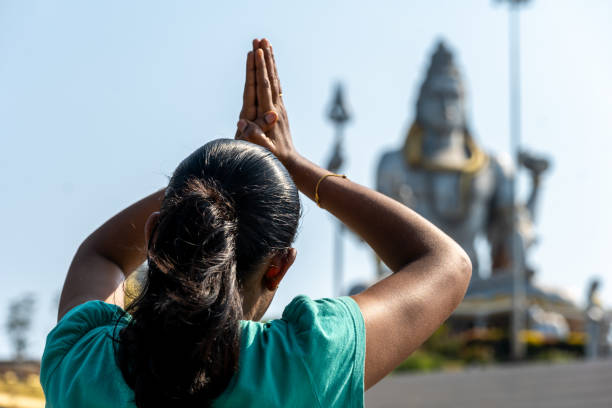Hello Everyone! Welcome to SasVibe. The Atma Linga, revered as one of the most sacred symbols in Hindu mythology, holds a captivating tale that intertwines devotion, deception, and divine intervention. This fascinating story not only highlights the immense power of the Atma Linga but also underscores the profound faith of devotees and the cosmic play of gods.
What is Atma Linga
The Atma Linga, also known as the Soul Linga, is a sacred symbol of Lord Shiva in Hindu mythology. It is believed to embody the divine essence and cosmic power of Shiva. The Atma Linga is central to a famous legend involving the demon king Ravana, who received it from Lord Shiva but was unable to take it to his kingdom due to divine intervention. The Atma Linga now resides in the Mahabaleshwar Temple in Gokarna, Karnataka, and is a significant pilgrimage site for devotees seeking Shiva’s blessings.
Origins of the Atma Linga
The story of the Atma Linga begins with Ravana, the mighty demon king of Lanka, who was an ardent devotee of Lord Shiva. Ravana’s devotion was unparalleled, and he sought the divine blessing of invincibility and immortality. To achieve this, he decided to worship Lord Shiva with great penance and devotion. Pleased with Ravana’s dedication, Lord Shiva appeared before him and offered him a boon.
Ravana, wise and strategic, requested the Atma Linga, a sacred symbol of Shiva’s divine essence. Possessing the Atma Linga would make Ravana invincible and immortal, as it contained the supreme power of Shiva himself. Lord Shiva agreed, but on one condition: the Atma Linga should not be placed on the ground until it reached Lanka, for if it did, it would become immovable.
The Deceptive Plan of the Devas
The granting of such immense power to Ravana alarmed the Devas (gods), who feared the consequences of an invincible demon king. They devised a plan to prevent Ravana from taking the Atma Linga to Lanka. Lord Vishnu, the preserver, and Lord Ganesha, the remover of obstacles, played crucial roles in this divine conspiracy.
As Ravana journeyed towards Lanka with the Atma Linga, Lord Vishnu created an illusion of dusk, making it seem as though the day was ending. Ravana, being a devout Brahmin, needed to perform his evening rituals but was reluctant to place the Atma Linga on the ground. At this moment, Lord Ganesha, disguised as a young boy, appeared before Ravana.
Ravana requested the boy to hold the Atma Linga while he completed his rituals, cautioning him not to place it on the ground. Ganesha, cunningly, agreed but laid down a condition that if Ravana took too long, he would place the Atma Linga on the ground and leave.
The Immovable Atma Linga
As expected, Ravana took longer than anticipated, and Ganesha, pretending to be tired, called out Ravana’s name thrice and then placed the Atma Linga on the ground. Ravana, realizing the deception, hurried to retrieve the Atma Linga, but all his efforts were in vain. The Atma Linga had become immovable, permanently fixed in the place where it was set down.
In his fury and frustration, Ravana tried to uproot the Atma Linga, but only succeeded in twisting its top. He then performed severe penance to atone for his anger. The place where the Atma Linga was set down became known as Gokarna, a revered pilgrimage site in the Indian state of Karnataka.
The Spiritual Significance
The Atma Linga holds immense spiritual significance for devotees of Lord Shiva. It symbolizes the supreme power and divine essence of Shiva, and the story of its journey and immovability underscores the themes of devotion, divine intervention, and the ultimate victory of the divine will over mortal desires.
Gokarna, where the Atma Linga is enshrined, attracts thousands of pilgrims who come to seek the blessings of Lord Shiva. The Mahabaleshwar Temple in Gokarna houses the Atma Linga and is a prominent site of worship, revered for its spiritual power and the legend that surrounds it.
The Mahabaleshwar Temple
The Mahabaleshwar Temple in Gokarna is one of the most significant pilgrimage sites for Shiva devotees. The temple, located in the Uttara Kannada district of Karnataka, is renowned for its Dravidian architecture and serene coastal surroundings. Pilgrims visit the temple to seek the blessings of Lord Shiva and to witness the Atma Linga, which is partially buried in the ground, symbolizing its divine immovability.
Rituals and Festivities
The temple is a hub of religious activities, especially during the Maha Shivaratri festival. Devotees from all over the country flock to Gokarna to participate in the elaborate rituals and ceremonies. The temple’s priests perform special poojas and abhishekams (ritualistic bathing of the deity) to honor the Atma Linga. The atmosphere is filled with chants and hymns dedicated to Lord Shiva, creating a spiritually uplifting experience for all visitors.
Visiting the Mahabaleshwar Temple
Travelers seeking a spiritual journey can visit the Mahabaleshwar Temple in Gokarna. The temple is well-connected by road and rail, making it accessible to pilgrims and tourists alike. Gokarna itself is a picturesque coastal town, offering visitors a blend of spiritual and scenic experiences. Along with the temple visit, tourists can explore the pristine beaches and the tranquil environment that Gokarna is known for.
Conclusion
The story of the Atma Linga is a timeless tale that continues to inspire and captivate devotees and spiritual seekers alike. It is a testament to the boundless devotion of Ravana, the strategic intervention of the Devas, and the enduring power of divine will. The Atma Linga, with its rich history and profound spiritual significance, remains an eternal symbol of the cosmic play of gods and the unwavering faith of devotees.



